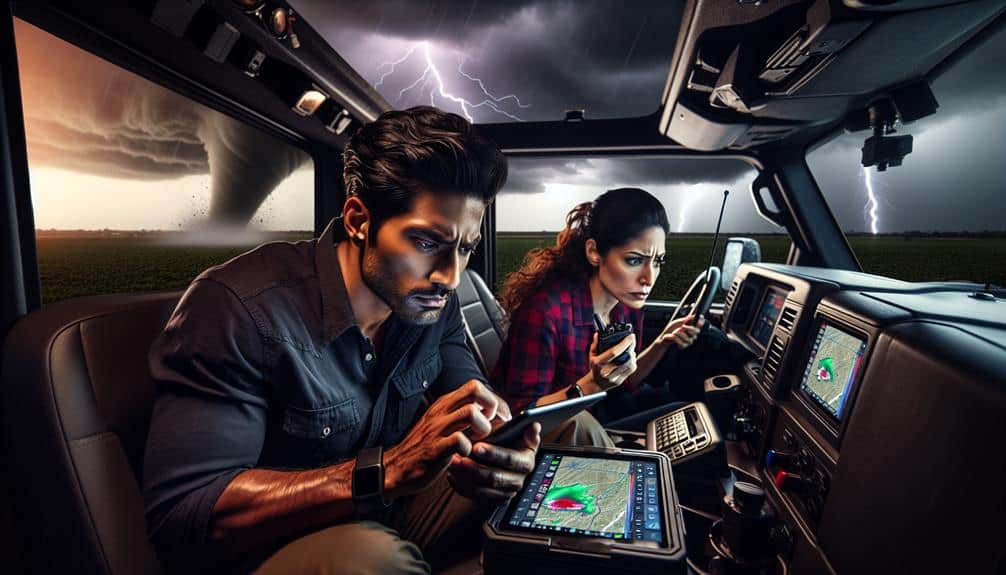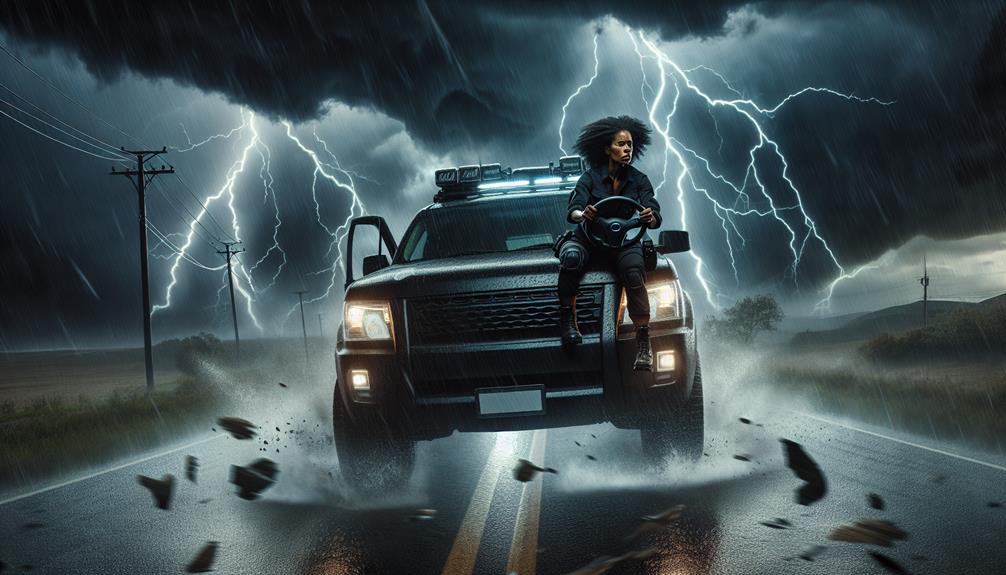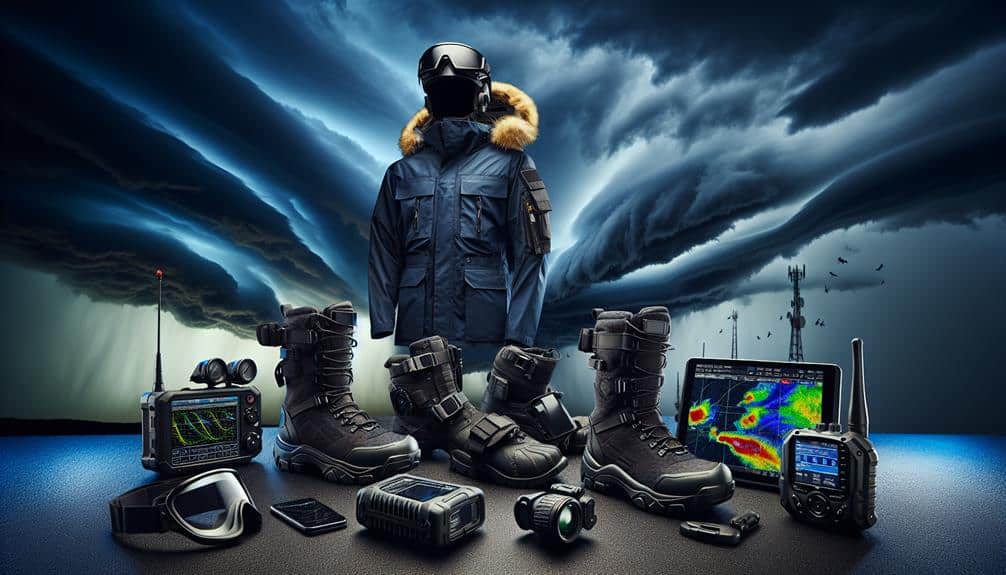To effectively chase storms, we need to analyze weather models and real-time radar data, ensuring precise understanding of storm behaviors. Prioritizing vehicle readiness, we check tire pressure, fluid levels, and emergency supplies. Safe route selection is essential, favoring paved roads while avoiding flood zones, and monitoring traffic updates. Controlling speed and maintaining distance helps adapt to slippery conditions and sudden weather changes. Reliable communication, using radio frequencies and updated emergency contacts, is crucial. In heavy rain, moderate speeds, proper lighting, and functional wipers enhance safety. Effective crisis management requires calm, clear communication and pre-planned actions. There's much more to master next.
Key Points
- Prioritize Safety: Conduct thorough vehicle inspections and ensure all emergency supplies and communication devices are functional.
- Monitor Weather: Use radar and Doppler data to track storm patterns and make informed decisions on positioning.
- Plan Routes: Stick to paved roads, avoid flood-prone areas, and use real-time traffic apps for efficient navigation.
- Control Speed: Drive at a safe, controlled pace to maintain traction and avoid hydroplaning or losing control.
Understanding Storm Patterns
To effectively pursue storms, we must first analyze and understand the various patterns and behaviors that storms exhibit. Storm behavior is inherently complex, driven by atmospheric dynamics that require precise prediction techniques. We need to harness our skills in meteorology to interpret weather models, which forecast storm development and movement. By understanding these models, we can anticipate storm paths and potential severity.
Weather radar systems are indispensable tools for us. They provide real-time data on storm structure, intensity, and movement. Using Doppler radar, we can identify rotation within supercells, which may indicate tornado formation. Tracking methods include analyzing radar imagery to pinpoint storm locations and their trajectories. This helps us make informed decisions on positioning ourselves for thorough observation and safety.
Our approach must be systematic. By combining forecasting techniques with real-time data from weather radar, we can develop a detailed understanding of storm behavior. This enables us to accurately track storms and adjust our strategies accordingly. Precision in these methods ensures that we optimize our storm-chasing efficiency while minimizing risks.
This analytical approach not only fuels our passion for freedom on the open road but also guarantees our safety as we pursue the most extreme weather phenomena.
Vehicle Preparation Tips
As we prepare for storm chasing, ensuring our vehicle is equipped and safe is critical.
We'll start with an essential equipment checklist, followed by a thorough safety inspection routine.
This approach minimizes risks and optimizes our readiness for severe weather conditions.
Essential Equipment Checklist
Before starting on any storm chasing journey, we must make sure our vehicle is equipped with a thorough set of essential tools and safety gear. Our preparedness can make a significant difference in safely navigating the unpredictable conditions we'll face. Key items fall into categories such as emergency supplies and communication devices.
Here's a concise checklist to guide our preparation:
- Emergency Supplies: A well-stocked first aid kit, fire extinguisher, and emergency blankets are vital. These items guarantee we can handle minor injuries or stay warm if stranded.
- Communication Devices: Reliable communication is essential. Equip our vehicle with a CB radio, a fully charged satellite phone, and a GPS unit. This ensures we can stay in contact and find our way effectively even in remote areas.
- Weather Monitoring Tools: Portable weather radios, anemometers, and barometers help us track storm developments in real-time, allowing for swift and informed decisions.
- Vehicle Maintenance Gear: Jumper cables, tire repair kits, and a set of essential tools (screwdrivers, wrenches) are necessary. This equipment ensures we can address minor mechanical issues without delay.
Safety Inspection Routine
Once our vehicle is equipped with the necessary tools and safety gear, we must conduct a thorough safety inspection to make sure it's in top condition for the challenges ahead.
First, let's check the tire pressure; it's essential for maintaining traction on wet and uneven surfaces. We should refer to the manufacturer's recommended PSI and use a reliable gauge to measure each tire, including the spare.
Next, we'll inspect the brake pads. Worn brake pads can severely impact stopping power, which is non-negotiable when maneuvering through unpredictable storm paths. If the pads are less than a quarter-inch thick, it's time to replace them.
Additionally, we must examine fluid levels—oil, coolant, brake, and transmission fluids. These levels should be within the best range to ensure the vehicle operates smoothly under stress.
Lastly, let's verify the battery's health. A multimeter can help us measure the voltage, ensuring it falls within the 12.4 to 12.7-volt range when the engine is off.
Choosing Safe Routes

When choosing safe routes, we need to prioritize paved roads to guarantee stability and traction.
We should avoid flood-prone areas to prevent getting stranded or swept away.
Additionally, let's monitor real-time traffic to steer clear of congestion and potential hazards.
Prioritize Paved Roads
Exploring storm-chasing routes, we should prioritize surfaced roads to enhance vehicle stability and minimize the risk of getting stuck. While off-road alternatives may seem enticing for closer storm tracking, they present significant risks, including vehicle immobilization and damage.
Surfaced roads offer a stable surface, essential for maintaining control during rapidly changing weather conditions. To guarantee effective storm chasing, let's break down the advantages:
- Vehicle Stability: Surfaced roads provide a consistent surface, reducing the risk of skidding or losing traction.
- Predictable Navigation: Surfaced routes are mapped and maintained, decreasing the likelihood of encountering unexpected obstacles.
- Weatherproofing Vehicle: Utilizing surfaced roads minimizes exposure to rough terrains that can compromise our vehicle's integrity and storm safety features.
- Quick Evacuation: Surfaced roads enable faster, safer exits if the storm's path shifts unexpectedly.
Prioritizing surfaced routes doesn't mean we ignore off-road alternatives entirely. Instead, we should assess the terrain and weatherproof our vehicle accordingly, ensuring it's equipped for any sudden storm-induced challenges. This approach not only enhances our storm tracking efficiency but also ensures our safety and freedom to maneuver effectively in any situation.
Avoid Flood-Prone Areas
In addition to prioritizing surfaced roads, we must be cautious about avoiding flood-prone regions to guarantee our routes remain safe and navigable during storm chasing. Flood-prone zones pose significant risks, especially when storms can cause rapid water accumulation. We need to identify these areas in advance using topographical maps and flood history data. This preparation allows us to design routes that steer clear of these hazards.
When planning our journey, we should integrate flood response strategies into our decision-making process. This includes being aware of low-lying areas, riverbanks, and poorly drained urban regions. Implementing emergency protocols, such as having an alternative route ready, ensures we can quickly adapt if our primary path becomes compromised.
Additionally, it's important to stay updated on weather forecasts and flood warnings issued by local authorities. These alerts can provide real-time information that might necessitate a change in our plans. By incorporating these measures, we enhance our ability to navigate safely while maintaining the freedom to chase storms effectively.
Our commitment to avoiding flood-prone regions not only reinforces our safety but also guarantees we can focus on capturing the most compelling storm phenomena.
Monitor Real-Time Traffic
We must actively monitor real-time traffic data to select the safest and most efficient routes during storm chasing. This is essential for maintaining our safety and ensuring we can get to the storm without unnecessary delays.
Let's break it down into actionable steps:
- Utilize Traffic Apps: Leverage reliable traffic apps like Google Maps or Waze. These tools provide real-time traffic conditions, highlighting potential road closures and congested areas. This allows us to reroute swiftly if needed.
- Follow Emergency Response Updates: Stay tuned to local emergency response updates. These updates often contain vital information on road conditions, closures, and areas to avoid, ensuring we're always informed and can make quick decisions.
- Monitor Social Media: Platforms like Twitter can be invaluable during storm chasing. Follow local traffic and emergency response accounts for up-to-the-minute reports on road conditions and closures.
- Use GPS Devices with Live Traffic: Dedicated GPS devices with live traffic updates offer an additional layer of information. These devices often include features specifically designed for navigation during emergencies.
Managing Speed and Distance
Maintaining best velocity and spacing is crucial for safely traveling through severe weather while storm chasing. We need to prioritize velocity control to adapt to rapidly changing conditions. By driving at a controlled pace, we keep our vehicle stable and uphold traction on slippery roads. Sudden acceleration or deceleration can lead to loss of control, which is particularly hazardous in stormy conditions.
Equally significant is upholding distance from other vehicles and the storm itself. Keeping adequate spacing allows us to react to unforeseen changes in both weather and traffic. A safe trailing distance provides us with sufficient time to respond if the vehicle ahead suddenly brakes or if debris blocks the road.
Furthermore, maintaining a buffer zone from the storm ensures we evade the most perilous areas while still collecting vital data.
We must consistently adjust our velocity and spacing based on real-time observations. For example, when visibility decreases, we should decrease velocity and increase trailing distance. This approach reduces risks and improves our capacity to make prompt, secure decisions.
Communication Best Practices

Effective communication is essential in ensuring all team members stay informed and coordinated while navigating severe weather conditions. We need to establish clear channels and protocols to maintain seamless interaction. Here are four best practices for effective communication during storm chasing:
- Weather Updates: Regularly share weather updates through our communication channels. This keeps everyone informed about changing conditions and helps in strategizing our next moves.
- Team Coordination: Use dedicated radio frequencies for team coordination. This guarantees that all relevant information is transmitted instantly and received by every team member.
- Emergency Contacts: Maintain a list of emergency contacts that's easily accessible. In case of unexpected situations, having quick access to these contacts can be vital.
- Radio Communication: Make sure that our radio communication devices are fully functional and have a backup battery. Reliable communication tools are essential for maintaining contact in remote areas where cell service may be unreliable.
Driving through heavy rain demands heightened attention and precise handling to guarantee safety. Our first priority should be hydroplaning prevention. To achieve this, we need to maintain moderate speeds and avoid sudden movements. Keeping a safe distance from other vehicles is crucial, as it provides more reaction time.
Visibility strategies are necessary. We must use our low-beam headlights and check that our windshield wipers are in top condition. Regular windshield wiper upkeep includes inspecting for wear and replacing blades every six months. This ensures peak performance, especially in torrential rain. Additionally, proper defogging methods are essential to keep our view clear. Utilizing the defroster and air conditioning can quickly eliminate interior fog, enhancing visibility.
We should also steer clear of driving through large puddles, as they can hide hazards and contribute to hydroplaning risks. If we do come across standing water, it's best to drive slowly and steadily.
Furthermore, keeping our tires properly inflated and monitoring tread depth can greatly reduce the chances of hydroplaning.
Handling Emergency Situations

When we're faced with emergency situations on the road, quick thinking and decisive actions are important to guarantee our safety. Effective emergency response and crisis management can make a significant difference while storm chasing.
Let's break down the key steps to handle emergencies efficiently:
- Stay Calm and Assess: The initial response should always be to stay composed. Panic clouds judgment and delays important actions. Assess the situation accurately—whether it's a vehicle malfunction, sudden weather change, or a road hazard.
- Communicate Clearly: Confirm that all team members are aware of the situation. Use clear, concise language and ensure that everyone understands their role in the emergency response. If needed, communicate with local authorities for assistance.
- Execute Pre-Planned Actions: We should always have a crisis management plan in place before heading out. This plan should include steps like finding the nearest safe location, contacting emergency services, and securing the vehicle.
- Review and Learn: After the emergency is resolved, we need to review the incident. Analyze what went well and identify areas for improvement. This continuous learning process is essential for refining our strategies and enhancing our preparedness.
Frequently Asked Questions
What Essential Apps Should Storm Chasers Have on Their Phones?
We should download apps for safety precautions, GPS tracking, weather alerts, and communication tools. These include RadarScope for real-time weather data, Life360 for GPS tracking, and Zello for instant communication. Freedom depends on preparedness.
How Do You Maintain Morale on Long Storm Chasing Trips?
To uphold morale, we focus on team bonding activities and prioritize mental health by taking regular breaks. Engaging in fun, interactive tasks keeps our spirits high and guarantees we stay mentally sharp during long storm chasing trips.
What Are the Best Times of Year for Storm Chasing?
The best times for storm chasing are during the storm season, typically spring and early summer. Weather patterns, like cold fronts and drylines, frequently create ideal conditions for severe thunderstorms, offering us the greatest opportunities for observation.
How Do You Document Your Storm Chasing Experiences Effectively?
To document our storm chasing effectively, we use high-resolution cameras and follow photography tips like using wide-angle lenses. Our storm chasing team dynamics guarantee coordinated efforts, capturing every angle while maintaining safety and freedom to explore.
What Are the Ethical Considerations in Storm Chasing?
When considering ethical storm chasing, we prioritize public safety, minimize environmental impact, and respect private property. We guarantee our actions don't endanger others, avoid contributing to debris, and never impede emergency services or locals.


